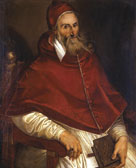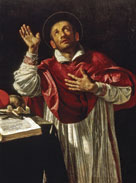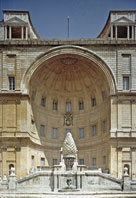|
A semester spent studying abroad in Italy provides a transcendent
experience for most students, but for a select few, the journey
can be epiphanous.
Such was the case for John Alexander, an architectural historian
at Texas A&M’s College of Architecture, who as an undergraduate
spent an influential summer in Italy while studying architecture
at the University of Detroit. That “formative experience” launched
Alexander on a career path that a few years later found him tucked
away in the archives of the 400-year-old Collegio Borromeo in
Pavia, Italy, passionately perusing obscure 16th Century manuscripts
for a dissertation examining the architectural patronage of Saint
Carlo Borromeo (1538 – 1584). Canonized in 1610, Borromeo
had served as Archbishop of Milan, Cardinal-Priest of the Roman
titular church of S. Prassede, Papal Secretary to his uncle and
mentor, Pope Pius IV (who reigned 1559 – 1565), and founder
of the Collegio Borromeo, for whom the institution and the building
were named.
Alexander’s discoveries during that 26-month project in
Italy not only earned the young scholar a doctorate from the
University of Virginia, it brought to light a captivating story
about Pius IV’s mentorship of Borromeo and rescued from
obscurity the integral role Pope Pius played in orchestrating
many of the massive architectural initiatives of the Counter-Reformation.
The discoveries also provided Alexander, who specializes in Italian
Renaissance and Baroque architectural history, with expansive
and challenging topics that have fueled more than 12 years of
scholarly inquiry and provided fodder for a book project currently
in the works.
“I never expected to come across the cache of documents
that I found at the Collegio and in other archives,” explained
Alexander. Among them were numerous correspondences between Borromeo
and his representatives in Milan and Pavia that illuminated the
chronology and methods employed in the design and construction
of the Collegio Borromeo — an edifice designed by Pellegrino
Tibaldi, which Alexander describes as “an enormous monument
of shocking design, unprecedented in its time and place for both
Its Mannerist design, and the scale of building for a residential
college.” But even more important were documents, previously
discounted or overlooked by scholars, that chronicled Borromeo’s
direct consultation with his uncle, Pope Pius IV, on issues related
to the college’s construction.
“I found that Borromeo was very much the pupil and protégé,
learning from Pius IV and fulfilling his wishes,” Alexander
explained. “The Pope wanted his nephew to be someone who
embraced learning, art and architecture and this whole wealth
of culture, and he saw Church reform as benefiting from that.”
This discovery prompted Alexander to delve deeper into Pius
IV’s role in other architectural projects. Though Pius
IV is perhaps best known for his role in concluding the Council
of Trent — the Catholic Church’s response to the
Protestant Reformation — Alexander found that Pius had
personally overseen a massive and unique building initiative
in the mid 16th Century. He had worked closely with the leading
architects of the day, including Michelangelo Buonarroti and
Pirro Ligorio, initiating projects to expand the city of Rome
and transform it into a religious capital. His projects, unlike
those of other popes, included several secular works and encompassed
a variety of architectural styles.
“Pius quite happily sponsored artistic, architectural
and intellectual endeavors,” Alexander said. “He
viewed architecture as an urbanistic art and his buildings demonstrated
the reform and resurgence of the Church in the setting in which
the faithful lived out their lives.”
Known as a moderate reformer among a host of more strident and
even puritanical contemporaries, Pius IV was an anomaly in a
time characterized by religious schisms and brutality. As Pope,
he relaxed the Church’s Index of Forbidden Books and reined
in the Inquisition.
“Pius had sought to similarly mold his nephew, the future
St. Charles, into what he considered to be an ideal Prince of
the Church: erudite, cultured, a magnificent patron yet serious
about his religious responsibilities,” Alexander said. “Ironically,
even during Pius' reign, Borromeo began to take a very different
approach, becoming much stricter and much more puritanical than
Pius IV.”
To fully appreciate Pius IV’s contributions to the architectural
landscape of 16th Century Italy, Alexander said, one must pull
apart the history of the Vatican Palace, or a specific basilica
in Rome, or one of many structures that underwent renovation
under the pope’s guidance. For instance, he continued work
on St. Peter’s Basilica; reinitiated projects like the
Belvedere courtyard at the Vatican and the Campidoglio, the seat
of the civil government in Rome; and ordered the design and construction
of a new ceiling in St. John Lateran, the cathedral of Rome.
He commissioned Pirro Ligorio to design the Casino of Pius IV
in the Vatican Gardens and ordered one of Michelangelo’s
last works, the Porta Pia, a new portal in Rome’s ancient
Aurelian Wall. Underscoring Pius’ support of intellectual
pursuits, in addition to the Collegio Borromeo, he commissioned
two other buildings for educational institutions: the Archiginnasio,
for the University of Bologna, and the Sapienza, for the University
of Rome.
“Pius IV really did believe that social, educational,
political, artistic and intellectual agendas could support reform
of the Church,” Alexander said. “The buildings resulting
from his architectural programs attest to his enthusiasm and
wisdom in selecting architects. We are left with a picture of
a lively period in the history of Rome full of building projects
and intellectual development. Pius comes across as a sympathetic
character, striking a positive, optimistic note in a period characterized
by polarization and brutality.”
| |

John
Alexander

Portrait
of Pope Pius IV

Portrait
of Charles Borromeo

Collegio
Borromeo

Belvedere
Courtyard

Piazza
del Campidoglio
Larger
Images>>
|

